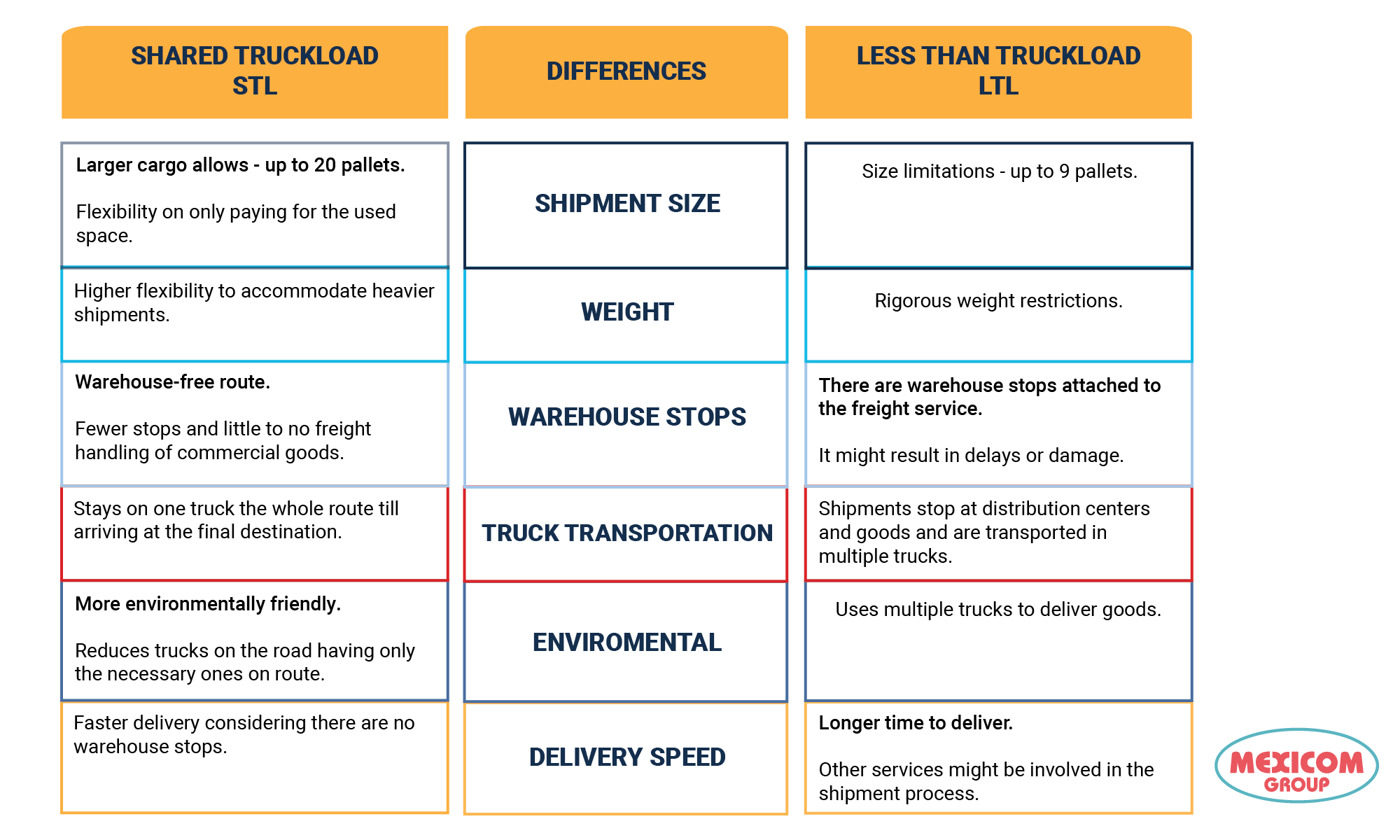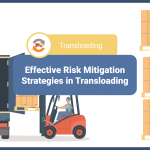Trends Shaping the Freight Transportation Industry for 2024
La version française sera disponible sous peu
The freight transportation industry is reshaping and having significant transformations for 2024. These trends are developing the way goods are moved and managed. We are going to see several key trends gaining momentum in the last couple of months and continue to evolve for the upcoming year. We are taking a closer look at how Artificial Intelligence (AI) is gaining attraction in the transportation industry. As well, as how people related to the industry are considering more and more sustainable transportation solutions. Especially because these trends are in high demand due to the customers no longer wanting to see traditional alternatives.
SHARED FREIGHT
In the last year, there’s been a need to optimize operations and conserve resources, there is also a surge in finding new solutions addressing transit time, risk damage, and transportation costs for trucking deliveries. A growing number of customers are actively seeking non-traditional alternatives, and Shared Truckload (STL) has emerged to be a viable solution. While this service has been available for a considerable time, customers were not capitalizing on it, resulting in its relatively lower popularity. However, there is a noticeable shift, and it appears that in the coming year, more people may be inclined to make greater use of this service.
How does Shared Freight work and Why is it Beneficial?
Shared Truckload (STL) entails the sharing of space, routes, warehousing, or distribution centers among multiple shippers. This approach involves consolidating shipments from various shippers into a single truck, resulting in reduced transportation costs and operational efficiency. When contrasted with conventional less-than-truckload (LTL), shared freight provides expedited transit time and decreases the risk of damage.
Opting for Shared Truckload (STL) shipping affords you the benefits typically associated with full truckload (FTL) shipping, all without the requirement to occupy or pay for an entire truck. This translates to minimized damage, expedited delivery times, exemption from accessorial fees, and more economical rates overall. Beyond these advantages, STL stands out as an environmentally conscious shipping mode. This is one of the main reasons why STL is looking to be more popular especially because the streamlined, shared truck space significantly reduces fuel wastage and unnecessary trips, contributing to a more sustainable and eco-friendly transportation option. Many people nowadays are looking to find a more sustainable option.
Shared Truckload (STL) vs. Less Than Truckload (LTL)
Less Than Truckload (LTL) shipping operates by consolidating multiple shipments to optimize trailer space utilization. LTL freight, weighing less than 7,500 pounds and occupying less than 12 feet of trailer space, does not necessitate the entire capacity of a truckload trailer. LTL freight ensures efficient use of truck space, leading to typically lower upfront costs compared to alternative shipping operations. However, LTL shipping faces a higher incidence of damage during transloading at warehouses and adds extra fees related to freight class, weight, and pickup and drop-off destination codes. Shared Truckload (STL) shipping takes a more direct and hubless route, resulting in a higher rate of damage-free deliveries.
The following comparison table outlines the key distinctions between STL and LTL shipping:

GREEN TRUCKING AND LOGISTICS
Over the past few years, there has been a growing concern among people regarding trucks contributing to greenhouse gas emissions, specifically in terms of carbon dioxide. This topic has been an ongoing conversation and remains a focal point of discussion. Finding alternatives that mutually benefit both customers and logistics partners has been an ongoing effort. While the focus on green trucking and logistics persists, people are actively seeking how to solve these challenges and making it a priority for the year 2024. To keep up with the latest trends in logistics and transportation, companies should adopt environmentally sustainable practices to minimize their impact on the environment.
How to solve the challenge of having green trucking and logistics?
Shared Truckload (STL) entails the sharing of space, routes, warehousing, or distribution centers among multiple shippers. This approach involves consolidating shipments from various shippers into a single truck, resulting in reduced transportation costs and operational efficiency. When contrasted with conventional less-than-truckload (LTL), shared freight provides expedited transit time and decreases the risk of damage.
Finding solutions to green trucking and logistics involves mitigating the environmental effects of freight transportation through the utilization of alternative fuels, electric trucks, hybrid trucks, and sustainable energy sources. Green trucking contributes to the reduction of greenhouse gas emissions, fuel expenses, and noise pollution, concurrently enhancing air quality and public health. Having innovative green trucking enterprises overseeing and taking action in applying these solutions will bring economic, social, and environmental advantages for customers, drivers, and communities.
In the green logistics realm optimizing transportation routes stands as a crucial component. Finding the most efficient routes requires the utilization of advanced transportation management systems while taking into consideration factors such as traffic patterns, weather conditions, and the weight and volume of goods. By minimizing the distance that commercial goods need to travel, it becomes possible to reduce both the carbon footprint of transportation and fuel consumption. Action on climate change on freight consolidation to reduce the amount of CO2 emissions is an action that needs to be taken and having more information about will bring more ways to solve these challenges.
TRUCKING AI (Artificial Intelligence)
There have been ongoing issues within the trucking industry, making it challenging to find solutions. The idea of using AI technology to address some of these problems appears promising. Consequently, more people are increasingly relying on this AI technology to make advancements in the transportation field. The trucking industry currently faces challenges like inefficient routes, unpredictable maintenance needs, and suboptimal load optimization. People in the trucking industry are starting to see that some of these challenges the AI might be able to address and help with route optimization, analysis of driver behavior, capacity utilization, and predictive analytics. For that reason, the trend of using AI technology is growing for the upcoming year.
In which areas of the trucking industry can we improve with the use of AI?
Some areas that could directly experience benefits are fuel consumption, cost reduction, and operational systems. AI algorithms assess factors such as load weight, road conditions, and driving behavior to optimize fuel consumption. These AI systems offer real-time feedback to drivers, encouraging the adoption of fuel-efficient driving techniques. AI technologies can predictive analytics in the anomalies of fuel usage this could empower companies to implement strategies that effectively reduce fuel waste and at the same time reduce costs. The AI technology also helps increase efficiency internally within third-party logistics companies.
AI technologies utilize route planning algorithms that take into account real-time traffic data, weather conditions, and various variables to optimize truck routes. Through the analysis that the AI makes of historical and current data, these systems can pinpoint the most efficient routes, resulting in reduced travel time and minimized fuel consumption. People involved with the transportation industry are starting to see the effects of AI in real life and highly consider using this type of technology.
AI algorithms contribute to enhanced internal efficiency within third-party logistics companies. The systems employed by Mexicom Logistics are utilized to plan its operations with artificial intelligence. This enables better internal coordination, resulting in improved service quality and providing more accurate information to our clients.
EXPECTED RATES FOR 2024
Several external factors will influence the cost of LTL and FTL services in 2024:
- Demand: There has been an increase in e-commerce demand over the past year, and it continues to grow. This increase is leading to higher demand and elevated transportation prices.
- Fuel Cost: This is an influential factor that the transportation industry often has zero control over. The high and unexpected fluctuations make fuel prices rise, resulting in increased trucking prices.
- Shortage: Throughout this year, the shortage of drivers and trucking personnel has been a persistent issue that we will continue to see for next year, and which will only contribute to higher prices for shipping freight.
In a recent article, we found out the projection rates trucking companies are having for 2024 in North America.
Dry Van rates are at $2.76 USD per mile.
Typically paired with a non-temperature-controlled sealed trailer, it serves as a reliable benchmark for the average cost per mile in truckload freight.
Comparison with previous years: average of $2.30 – $2.86 USD per mile.
Flatbed rates are at $3.14 USD per mile.
This vehicle is equipped with a flat open trailer at the rear. Ideal for transporting wide loads, it simplifies the loading and unloading process.
Comparison with previous years: average of $2.47 – $3.19 USD per mile.
Refeer rates are at $3.19 USD per mile.
These trucks are equipped with refrigeration units to transport goods requiring precise temperature control. Reefer freight rates surpass those of other trucks, mainly due to higher fuel consumption.
Comparison with previous years: average of $3.14 USD per mile.
Overall, these are inevitable factors that will impact trucking industry rates for customers shipping across North America. However, projections indicate that in the second half of the next year, things will begin to settle down, providing a more favorable outlook. With anticipated improvement in the freight volume in North America, there are positive changes ahead.
SUPPLY CHAIN TRANSPARENCY AND VISIBILITY
Another trend that keeps developing over the years is the structure of the supply chain. Many changes have been made and led to successful results. For the upcoming year is expected to keep growing in the direction of transparency and visibility. Following on the supply chain tracks for 2024 is expected that companies will put more emphasis on working closely with their suppliers, manufacturers, customers, carriers, and distributors. This is to gain visibility on the whole supply chain process. On the transportation side of things gaining tracking visibility on shipments is what most consumers are looking for to enhance their businesses.
How can supply visibility be gained?
Supply chain visibility means that businesses can follow their products as they move from suppliers to customers, from the beginning to the end. This is important for companies because it helps them know the operation is going smoothly. Thanks to supply chain visibility, companies can know exactly where their products and materials are and decide the best ways to improve how they manage their supply chain. Having visibility into the supply chain has a lot of benefits, like reducing the chance of recalling products, cutting production costs, and making customers happier. Having real-time visibility into the supply chain will allow businesses to cut costs by identifying and using the most efficient routes more effectively. Also, the correct use of supply chain management can efficiently co-exist and have visibility gained.
Companies like Mexicom Logistics provide their clients with a valuable tool for enhancing supply visibility. Customers have the capability to track units through the utilization of the Macropoint system in the United States and mirrored accounts in Mexico. Using this system also helps us provide our clients with up-to-date and detailed reports on the status of all their shipments. This approach we are currently seeing Mexicom Logistics take goes along the same lines as the trends we are looking for in the upcoming year.
LABOR SHORTAGE
As the logistics industry keeps growing, a big problem is that there aren’t enough people to do the work. There aren’t enough skilled workers to meet all the required qualifications and the lack of both equipment and use of technology are some of the reasons why workers are not being properly hired. Which leads them to either losing their job or companies having to dismiss them.
This shortage is causing delays, making things more expensive, and slowing things down in the supply chain. Come back to the main issue in the logistics industry is that there aren’t enough skilled workers. Even though more logistics jobs are needed because of the growth of the trucking industry. This has made it harder for companies to find and keep good workers because they have to pay more to attract them. The shortage of skilled workers is a big challenge for the logistics industry today.
WAREHOUSING TRENDS
WAREHOUSE SUSTAINABILITY
Warehouse sustainability is all about trying to make warehouses have less impact on the environment. We will keep seeing this trend of being more sustainable and conscious of the environment. Warehouses can be more sustainable in many different ways, however, the focal point of this upcoming trend is helping cut down on carbon emissions and waste, primarily.
Some solutions that can be implemented and help solve the problem are:
Green Logistics: Logistics companies and 3PLs are becoming aware of how to plan the best transportation routes, not only to cut costs but also to ensure there’s no unnecessary extra mileage making operations more sustainable. Having local warehouse partners can help move and store products in large quantities across different areas. This way, they can deliver locally and cut down on extra carbon emissions.
Renewable Energy: Warehouses are going to start using solar panels on their roofs to make their own electricity. This helps them use less fossil fuels and use more renewable energy.
Eco-Friendly Packaging: Choosing packaging made from sustainable materials like eco-friendly, compostable, or recycled materials is a good step toward being more environmentally friendly.
WAREHOUSE AI (Artificial Intelligence)
Warehouse management is getting more involved with using AI. Technology is something we can’t escape nowadays and many companies and starting to opt in to using this kind of alternative because they see the results and want to stay relevant in the business. Continuing with the trends AI technology is something we are going to keep seeing and will have to get used to it because is the direction we are headed towards.
With Artificial Intelligence (AI) algorithms gather, analyze, and make decisions based on the data collected. This enables the AI in various aspects of warehouse operations to enhance and streamline processes. Moreover, AI algorithms can utilize their analysis of past data to predict future trends, like forecasting demand or anticipating supply chain challenges. This helps in avoiding unforeseen issues or demands that could have previously disrupted or stopped warehouse operations.
Some solutions that can be implemented and help solve the problem are:
The trends identified in the freight transportation scene for 2024 underscore the industry’s commitment to efficiency, sustainability, and technological advancement. From the rise of Shared Truckload solutions optimizing delivery processes to the growing importance of green logistics and the integration of AI in warehouse management, these trends reflect a collective effort to address challenges, improve operations, and meet the evolving needs of a dynamic marketplace. As companies continue to embrace these trends, the year 2024 holds the promise of a more streamlined, sustainable, and technologically advanced future for the freight transportation industry.
Usage of AI Predictions: Having AI analyzes historical warehouse data and market trends, it can forecast how demand will change in the future. This capability enables warehouses to proactively adjust stock levels, preparing for fluctuations and avoiding delays caused by waiting for stock deliveries.
AI Routes: Optimizing picking routes is a crucial step to enhance warehouse efficiency and expedite product delivery to customers. AI examines current picking routes and product locations, utilizing this data to generate the most efficient routes for workers.
AI Supply Chain: Anticipating future disruptions and trends in the supply chain by allowing the AI to examine past data and current trends. Gaining insight and maintaining control over the supply chain is invaluable for preventing stock issues and maintaining optimal inventory levels.
SOURCES:
https://www.forbes.com/sites/forbestechcouncil/2023/10/24/six-trends-for-shipping-and-logistics-globally-in-2024-and-beyond/?sh=71f38dc95e20
https://www.cnbc.com/2023/11/07/freight-recession-will-continue-in-2024-cnbc-supply-chain-survey.html#:~:text=The%20survey%20shows%20expectations%20for,a%2015%25%20increase%20is%20anticipated










